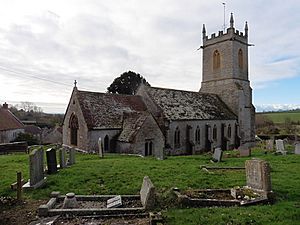Church of St John Baptist, Pitney facts for kids
Quick facts for kids Church of St John Baptist |
|
|---|---|
 |
|
| Location | Pitney, Somerset, England |
| Built | 13th and 14th century |
|
Listed Building – Grade II*
|
|
| Official name: Church of St John Baptist | |
| Designated | 17 April 1959 |
| Reference no. | 1056546 |
| Lua error in Module:Location_map at line 420: attempt to index field 'wikibase' (a nil value). | |
The Church of St John Baptist is an old church located in Pitney, a village in Somerset, England. It was built a very long time ago, in the 13th and 14th centuries. This means parts of it are over 700 years old! It is officially recognized as a Grade II* listed building, which means it's a very important historic building that needs to be protected.
Contents
A Look Back in Time
How Old Is the Church?
The main part of the church was built in the 1200s. The tall tower, which holds the church bells, was added later in the 1300s. Imagine how many people have walked through its doors over the centuries!
Changes Over the Years
Like many old buildings, the Church of St John Baptist has been updated. In 1853 and 1874, during the Victorian era, big changes were made. This work is called a "Victorian restoration." During this time, parts of the church were rebuilt. For example, a "west gallery" (a kind of balcony inside the church) was removed.
The Pitney Brooch Discovery
Something very exciting happened during the restoration work! Workers found a special bronze brooch. This brooch was from the Saxon period, which was over 1,000 years ago! This amazing find is now kept safe in the British Museum in London. It is known as the "Pitney Brooch."
The Church's Community
The Church of St John Baptist is part of a larger group of churches. It works together with churches in nearby villages like Drayton, Long Sutton, Long Load, and Muchelney. They are all part of the Langport Team Ministry, which is part of the Diocese of Bath and Wells. This means they share resources and work together to serve their communities.
What the Church Looks Like
Building Materials
The church is made of stone, with special decorative parts called "hamstone dressing." Hamstone is a type of golden-colored stone found in Somerset. The roofs are covered with clay tiles.
Inside the Church
The church has a long main area called a "nave" and a smaller area near the altar called a "chancel." It also has a "south transept," which is like a wing extending out from the side.
The Tower and Bells
The tower has three main sections and is supported by strong "buttresses" at its corners. Inside the tower, there are six bells. In 2014, two of the old bells were replaced, and an extra bell was added. This means the church now has a full set of six bells that ring out over the village.
Old Fittings and Furniture
Most of the furniture and decorations inside the church are from the 1800s, added during the Victorian restoration. However, some pieces are much older! The "pulpit" (where the priest gives sermons) and the "lectern" (where readings are given) are from the 1600s. The "font" (a basin used for baptisms) is even older, from the 1300s or 1400s, just like the original church building.
See also
- List of ecclesiastical parishes in the Diocese of Bath and Wells

